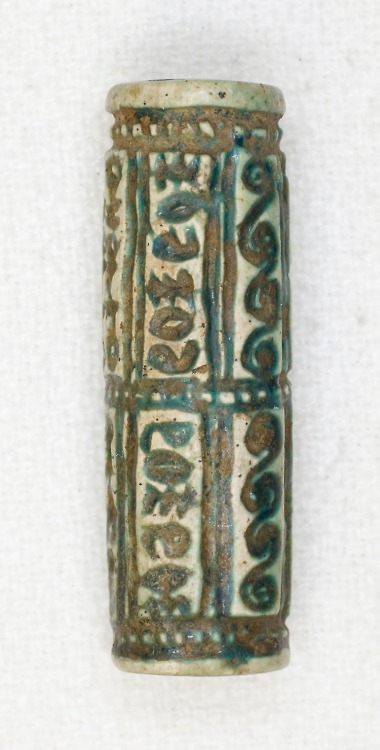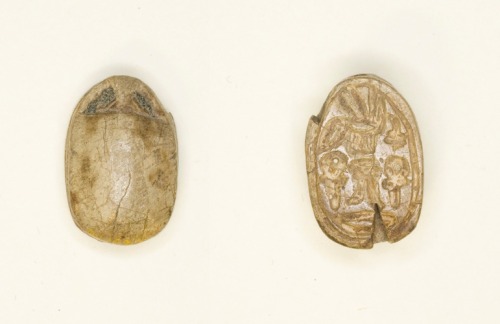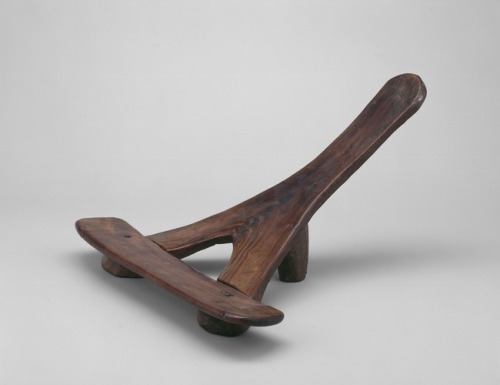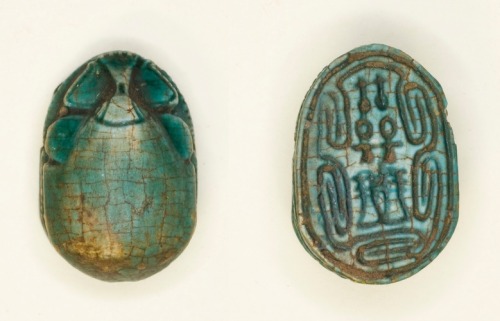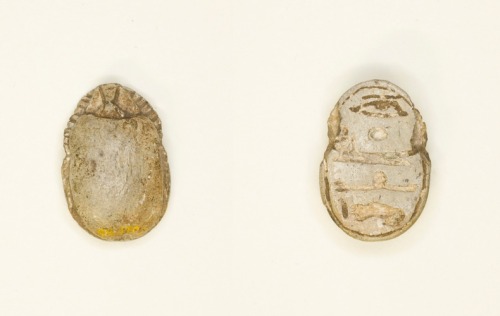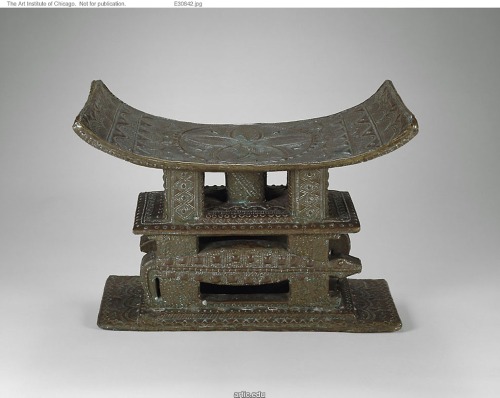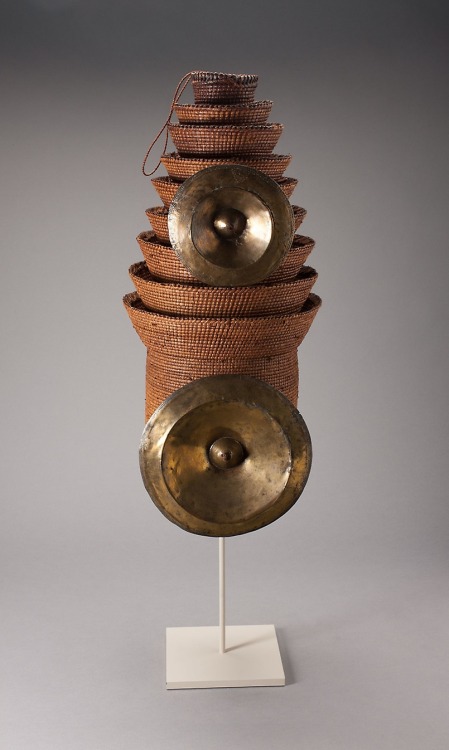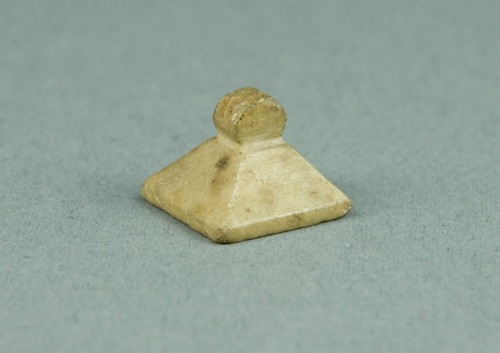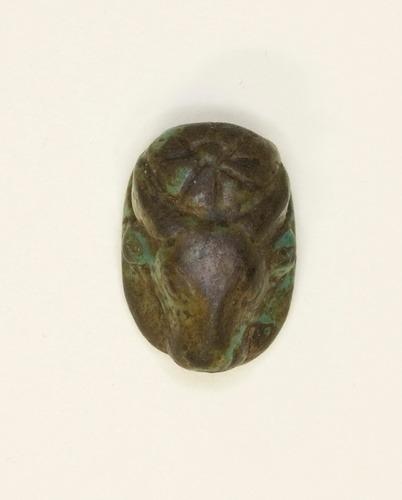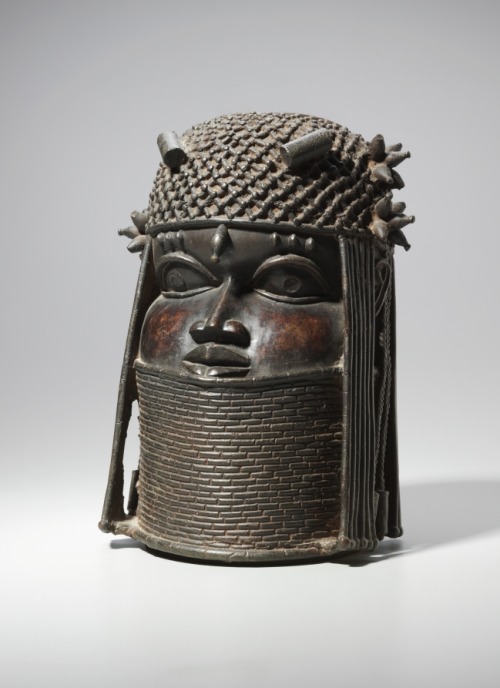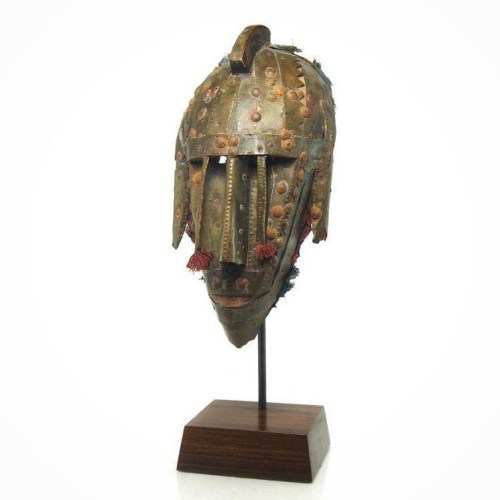#africanart
Cylinder with Geometric Designs and Hieroglyphs, Ancient Egyptian, -1650,Art Institute of Chicago: Arts of Africa
Gift of Henry H. Getty and Charles L. Hutchinson
Size: L. 2.9 cm (1 1/8 in.); diam. 1 cm (3/8 in.)
Medium: Glazed steatite
https://www.artic.edu/artworks/94858/
Post link
Scarab: Hieroglyphs (nsw-bity, Dd, anx, nb), Ancient Egyptian, -1985,Art Institute of Chicago: Arts of Africa
Gift of Henry H. Getty and Charles L. Hutchinson
Size: 1.6 × 1.1 × 0.6 cm (5/8 × 7/16 × ¼ in.)
Medium: Steatite
https://www.artic.edu/artworks/134228/
Post link
Crest Mask (Ngambak), Koro, 1900,Art Institute of Chicago: Arts of Africa
Constructed in three parts connected by pegs, this human-shaped headdress, richly decorated with geometric patterns in paint and pokerwork, is called ngambak (man with bowed legs). Serving as village guardians, headdresses of this kind were worn with tentlike fabric robes during agrarian dance festivals that marked the planting and harvesting seasons. They were typically destroyed or discarded after being used in performance. Through prior purchase from Mr. and Mrs. Nathan Cummings; through prior bequest of Joseph R. Shapiro; through prior gift of Deborah Stokes and Jeffrey Hammer; through prior purchase from Mrs. Leigh B. Block; and through prior gift of Richard Faletti, the Faletti Family Collection
Size: 87 × 31.1 × 20.3 cm (34 ½ × 12 ¼ × 8 in.)
Medium: Wood, pigment, resin, abrus seeds, and fiber
https://www.artic.edu/artworks/241910/
Post link
Tripod Chair, Tiv, 1901,Art Institute of Chicago: Arts of Africa
Based on the natural branching of a tree, this strikingly simple tripod chair seamlessly unites form with function. A horizontal plank placed across inverted limbs creates the chair’s seat. In Nigeria’s Benue River Valley, chairs are considered personal possessions and indicators of social rank. This chair was probably made to furnish a family’s reception room, where adults would eat, lounge, and receive guests. The smooth, glossy surface suggests regular use; it may have served as the favored seat of an elder, who sat upon it to rest and offer counsel. Gift of Marshall Field
Size: 55.9 x 86.4 x 86.4 cm (22 x 34 x 34 in.)
Medium: Wood
https://www.artic.edu/artworks/148334/
Post link
Scarab: Hieroglyphs (nfr-signs, anx-signs, Dd-signs), Ancient Egyptian, -2055,Art Institute of Chicago: Arts of Africa
Gift of Henry H. Getty and Charles L. Hutchinson
Size: 1.9 × 1.3 × 1 cm (¾ × ½ × 3/8 in.)
Medium: Glazed steatite
https://www.artic.edu/artworks/134318/
Post link
Plaque Amulet with the Name of the God Ptah, Ancient Egyptian, -1070,Art Institute of Chicago: Arts of Africa
Gift of Charles L. Hutchinson, Henry H. Getty, and Norman W. Harris
Size: 1.5 × 1 × 0.2 cm (9/16 × 3/8 × 1/16 in.)
Medium: Faience
https://www.artic.edu/artworks/135875/
Post link
Scarab: Nebmaatra (Amenhotep III), Ancient Egyptian, -1390,Art Institute of Chicago: Arts of Africa
Gift of Henry H. Getty and Charles L. Hutchinson
Size: 1 × 1.3 × 1 cm (¾ × ½ × 3/8 in.)
Medium: Faience
https://www.artic.edu/artworks/134029/
Post link
Scarab: Wish Formula, Ancient Egyptian, -1550,Art Institute of Chicago: Arts of Africa
Gift of Henry H. Getty and Charles L. Hutchinson
Size: 1.6 × 1 × 0.6 cm (5/8 × 3/8 × ¼ in.)
Medium: Steatite
https://www.artic.edu/artworks/134295/
Post link
Ceremonial Stool, Akan, 1950,Art Institute of Chicago: Arts of Africa
Stools are enormously significant for the Akan and are used in a variety of contexts. They constitute an important part of the furnishings of a household, carry symbolic meanings as icons of ritual power, and act as repositories of the souls of their deceased owners. This brass-covered stool most likely would have accompanied its owner to a public ceremony. Intended for display, it incorporates distincitive formal elements that reflect the patron’s wealth, status, and power. As is typical of the usual Akan stools, its carved, wooden, rectangular form consists of three parts–a top, a mid-section, and a base.This stool combines two distinct types. The first is the two-tiered, abstract form called obi-te-obi-so-dwa (one-sits-atop-another stool). This imagery visually communicates, and indeed validates, Akan social hierarchy, comprising individuals of diverse rank working in harmony. The second, or lower tier, featuring two crocodile motifs on front and back, reflects the stool form known as adenkyemdwa (crocodile seat). Important ritual objects (sometimes even altars) of Asante gods may be displayed on some stools during important public ceremonies. The sheet brass that covers the stool enhances the piece’s significance since brass (together with silver) is a preferred metal of the Akan religious elite. Moreover, the hammered, linear repoussé patterns–dots, circles, quatrefoils, lozenges, and crescents–that embellish the surface are reminiscent of designs usually found on Akan soul washers’ badges. Thus this stool must have belonged to either a priest or a politician with considerable ritual status.As symbols of authority, Akan stools are now inseparable form the idea of chiefship, the highest Akan political office. Not only must every Akan leader receive one as his personal, official emblem, but his legitimacy is often predicated on his use of a communally owned stool at his installation. Restricted gift of Mrs. James W. Alsdorf
Size: 43.8 x 62.2 cm (17 ¼ x 24 ½ in.)
Medium: Wood and brass
https://www.artic.edu/artworks/137130/
Post link
Ritual Container, Kisi, 1900,Art Institute of Chicago: Arts of Africa
Small pottery containers and figurines are among the ritual objects made throughout northeastern Tanzania for use in sacred practices, called ughanga, that are important in healing physical and psychological afflictions and misfortunes. Ughanga is, in fact, a multifaceted and adaptive institution that pervades much of society in northeastern Tanzania, and ughanga objects such as this receptacle hold medicines and in some cases embody spirits that can be called upon to aid in treatment. The medicines are made by traditional healers, called waghanga, who are expert herbalists and the keepers of cultural knowledge, history, and custom. They may administer their mixtures in a straightforward fashion or in conjunction with prayer, with the signing and dancing of spirit songs, and in ritual performances that unite all of these facets and allow the healer to engage with spirits and ancestors.In this container, a basic template is given a more sophisticated, anthropomorphized form. The human head that completes the vessel has the long nose, crested coiffure, round ears, and piercing eyes that typify figures made by the Kisi or Pare. The black-bead eyes, in particular, likely indicate that the figure was associated with a particularly powerful category of spirits that are symbolized by the color black. [See also 2005.278]. Gift of Keith Achepohl
Size: 24.1 x 17.8 cm (9 ½ x 7 in.)
Medium: Terracotta and glass beads
https://www.artic.edu/artworks/185688/
Post link
Chief’s Hat (Botolo), Ekonda, 1901,Art Institute of Chicago: Arts of Africa
This striking, well-preserved hat, or botolo, would have served as a critical component of an Ekonda chief’s public attire. Constructed out of woven raffia or cane fibers, it has nine brims in a pagoda-shaped tower and two brass or copper disks projected frontally from its base and upper portion. The disks may have been produced locally or imported from a neighboring group, and their primary function was to indicate wealth and prestige. On ceremonial occasions, these hats would often be treated with a combination of camwood powder and oil, which is what gives many of them their deep reddish hue.If a chief was the first in his line to rule, he would have to acquire a botolo, but hats of deceased rulers were generally preserved and passed down to their successors. The responsibilities of a chief, or nkumu, included the overseeing of all ceremonies, divinations, and other activities related to the spiritual well-being of his community. He had the exclusive right to the use of prestigious items, of which the botolo is the best known.—Permanent Collection Object Description Arnold Crane Endowment
Size: 49.5 × 24.1 cm (19 ½ × 9 ½ in.)
Medium: Fiber and copper alloy
https://www.artic.edu/artworks/140595/
Post link
Amulet of a Stamp Seal, Ancient Egyptian, -664,Art Institute of Chicago: Arts of Africa
Gift of Henry H. Getty, Charles L. Hutchinson, Robert H. Fleming, and Norman W. Harris
Size: 1.1 × 1.3 × 1.3 cm (7/16 × ½ × ½ in.)
Medium: Stone
https://www.artic.edu/artworks/140337/
Post link
Amulet of a Hedgehog, Ancient Egyptian, -1550,Art Institute of Chicago: Arts of Africa
Gift of Henry H. Getty and Charles L. Hutchinson
Size: 1.9 × 1.6 × 1 cm (¾ × 5/8 × 3/8 in.)
Medium: Steatite
https://www.artic.edu/artworks/140366/
Post link
Amulet of the God Khonsu as a Falcon, Ancient Egyptian, -664,Art Institute of Chicago: Arts of Africa
Gift of Henry H. Getty and Charles L. Hutchinson
Size: 3.5 × 1.6 × 0.6 cm (1 3/8 × 5/8 × ¼ in.)
Medium: Faience
https://www.artic.edu/artworks/140800/
Post link
Amulet of the God Bes, Ancient Egyptian, -1069,Art Institute of Chicago: Arts of Africa
Gift of Henry H. Getty, Charles L. Hutchinson, Norman W. Harris, and Robert H. Fleming
Size: 1.5 × .75 × .5 cm (9/16 × ¼ × 3/16 in.)
Medium: Faience
https://www.artic.edu/artworks/140894/
Post link
Scaraboid: Cow Head with Rosette, Ancient Egyptian, -1550,Art Institute of Chicago: Arts of Africa
Gift of Henry H. Getty and Charles L. Hutchinson
Size: 1.6 × 1.3 × 0.8 cm (5/8 × ½ × 5/16 in.)
Medium: Faience
https://www.artic.edu/artworks/134285/
Post link
Scaraboid: Crouched Human Figure Shown in Profile, Ancient Egyptian, -1550,Art Institute of Chicago: Arts of Africa
Gift of Henry H. Getty and Charles L. Hutchinson
Size: 1 × 0.6 × 0.5 cm (3/8 × ¼ × 3/16 in.)
Medium: Glazed steatite
https://www.artic.edu/artworks/134488/
Post link
Amulet of the God Amon, Ancient Egyptian, -1070,Art Institute of Chicago: Arts of Africa
Gift of Henry H. Getty and Charles L. Hutchinson
Size: 3.2 × 1.6 × 1 cm (1 ¼ × 5/8 × 3/8 in.)
Medium: Faience
https://www.artic.edu/artworks/136202/
Post link
Head, possibly mid 1500s or early 1600s,Cleveland Museum of Art: African Art
Metal arts flourished in the Benin kingdom from the 15th to the 19th century, until the British military sacked the Benin capital in 1897. This brass head depicts the divine Benin ruler cloaked in a headdress and collar of red coral beads. Such heads were ordered by a new king (oba) as centerpieces for the ancestral altar–an earthen platform–in honor of his deceased predecessor.
Size: Overall: 29.9 x 21.6 x 20.4 cm (11 ¾ x 8 ½ x 8 1/16 in.)
Medium: brass
Post link
Did you know that we have a wonderful selection of our rare African Artifacts online? This late 19th Century Marka Mask from Mali is one of my personal favorites, and it’s so wonderful to be able to look at so many photos of this stunning piece without ever having to leave home! Follow the tag in the lower left corner to see more photos and purchase! #marka #markamask #mali #africa #africanart #ethnicart #antiqueart #mask #antiquemask #africanmask #culture #beautiful #handmade #art #decorate #shop #nyc #unionsquare (at Beads of Paradise NYC)
https://www.instagram.com/p/CbLRURduTdJ/?utm_medium=tumblr
Post link

